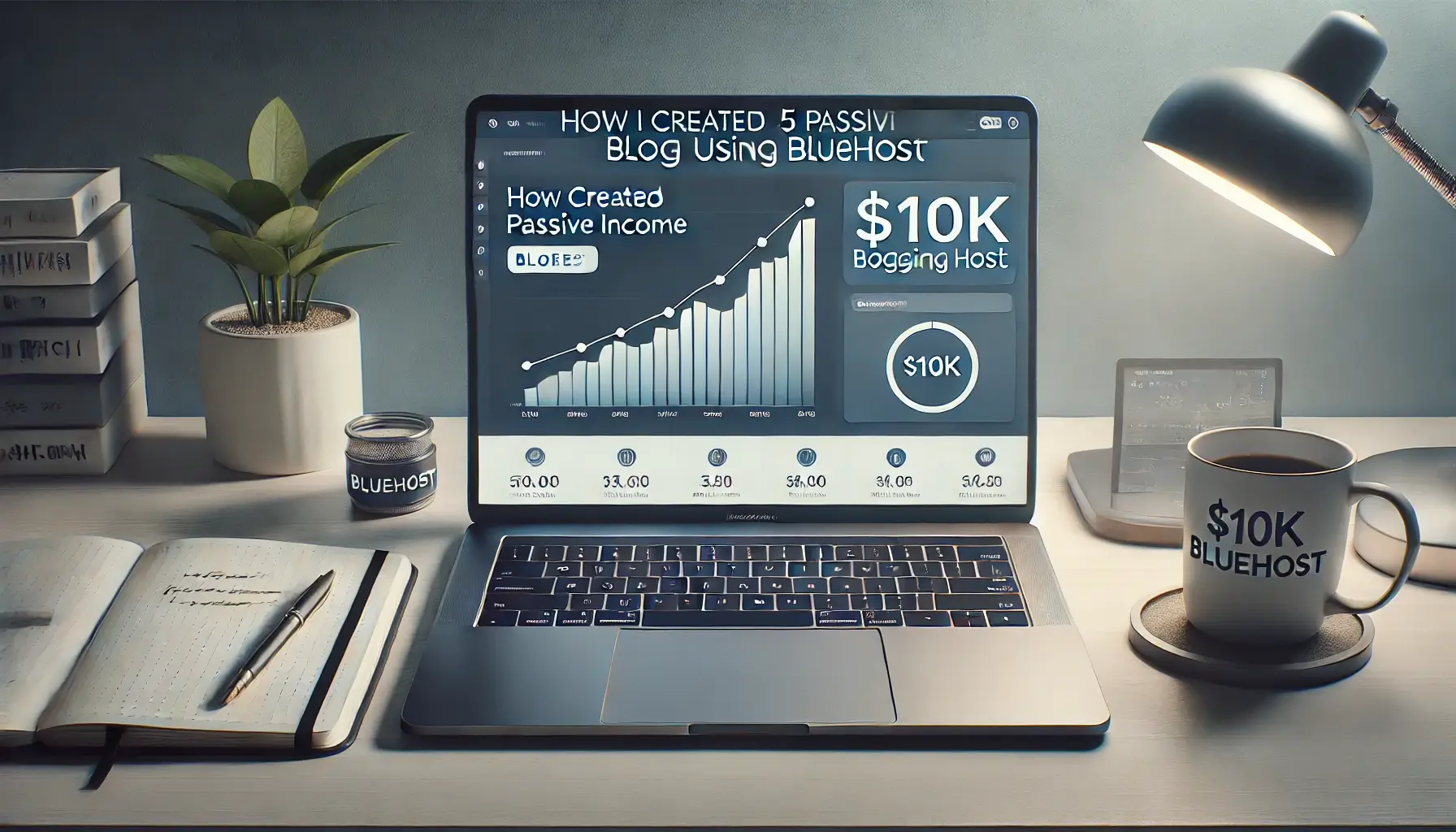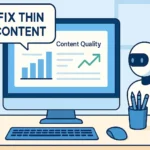How I Created a 5-Figure Passive Income Blog Using Bluehost (Step-by-Step Tutorial)

Introduction: My Journey to Building a 5-Figure Blog
This post will show you exactly how to start a blog with Bluehost and turn it into a $10,000/month passive income stream.
Three years ago, I was in your shoes—curious about blogging, unsure where to begin, and overwhelmed by the technical side of things. I had no idea that one decision would eventually lead to a full-time income and over 250,000 monthly visitors.
Today, my blog generates consistent revenue through affiliate marketing, digital products, and display ads—all built on a Bluehost-powered WordPress site.
In this step-by-step guide, I’ll walk you through everything I did to create, grow, and monetize my blog—from picking the right hosting plan to scaling traffic and building passive income.
For a broader overview of the blogging landscape, you might also want to check out my detailed resource: How to Start a Blog and Make Money in 2025: A Complete Beginner’s Guide.
Why Bluehost Is the Best Platform to Start a Blog in 2025
Before diving into the step-by-step process, let’s address why Bluehost stands out among dozens of hosting options:
- Beginner-friendly interface that doesn’t require technical expertise
- One-click WordPress installation (saving hours of setup time)
- Free domain name for the first year, reducing initial costs
- Excellent uptime (99.98%) ensuring your blog stays accessible
- Scalable hosting plans that grow with your traffic
- 24/7 customer support for resolving technical issues quickly
When I began researching hosting providers, these factors were crucial in my decision-making process. Three years later, I can confidently say Bluehost provided the stable foundation my profitable blog needed.
Step 1: How to Start a Blog with Bluehost – Account Setup & WordPress Installation
Let’s start with the technical setup and walk through how to start a blog with Bluehost, made simple even for complete beginners.:
Choosing the Right Bluehost Plan to Start Your Blog Strong
- Visit Bluehost’s official website
- Select “WordPress Hosting” from the top menu
- Review the plan options (I recommend the “Basic” plan for beginners)
- Click “Select” on your chosen plan
Pro Tip: While the Basic plan is sufficient to start, consider the Plus plan if you plan to launch multiple blogs simultaneously, as it allows unlimited websites.
Securing Your Domain Name
Your domain name is your blog’s permanent address online. When choosing:
- Keep it short and memorable
- Include keywords related to your niche when possible
- Avoid hyphens and numbers that complicate verbal sharing
- Stick with .com extensions when available for better brand recognition
I spent two full days brainstorming domain names while learning how to start a blog with Bluehost—time well spent considering it now represents a valuable brand asset.
Completing the Registration Process
After selecting your plan and domain:
- Create a Bluehost account with a secure password
- Select your plan term (I chose 36 months for maximum savings)
- Review package extras (Domain Privacy is essential; others are optional)
- Complete payment information
- Check your email for confirmation details
Installing WordPress
Bluehost simplifies WordPress installation with their automated setup:
- Log into your Bluehost account
- Navigate to “My Sites” section
- Click “Create Site”
- Enter your site name and tagline
- Click “Next” and Bluehost will automatically install WordPress
Once you’ve learned how to start a blog with Bluehost, your WordPress site will be ready to customize within 5–10 minutes!
Step 2: Optimizing Your Bluehost Blog for Long-Term Success
With the technical foundation established, I focused on optimization choices that would support future growth:
Selecting a High-Performance Theme
Your theme determines both your blog’s appearance and performance. After testing several options, I recommend:
- Astra: Lightweight and highly customizable
- GeneratePress: Exceptional loading speed
- Kadence: Built-in schema markup for better SEO
I ultimately chose Astra Pro for my blog due to its flexibility and speed optimization features.
Essential Plugins for a Professional Blog
While minimizing plugins improves site speed, these are worth installing:
- Yoast SEO or Rank Math: Optimizes content for search engines
- WP Rocket: Improves loading speed through caching
- Akismet: Blocks spam comments
- UpdraftPlus: Automated backups
- Elementor: Simplifies content design without coding
Important Security Measures:
- Install Wordfence for malware scanning and firewall protection
- Enable two-factor authentication
- Update plugins and themes promptly
- Use strong passwords for all accounts
These optimization steps saved me countless headaches down the road and established a solid foundation for growth.
Step 3: Content Strategy After Starting a Blog with Bluehost
The difference between hobby blogs and profitable ones often comes down to strategic content planning:
Finding a Profitable Niche
Rather than selecting a topic based solely on passion, I used these criteria to identify a profitable niche:
- Commercial intent: Do people spend money in this space?
- Competition level: Is there room for a new voice?
- Personal knowledge: Can I provide unique insights?
- Long-term viability: Will this topic remain relevant for years?
While exploring how to start a blog with Bluehost, I used Ahrefs to research profitable niches and found an underserved segment in personal finance.
If you’re looking to monetize quickly, check out my research on Best Affiliate Programs for Beginners in 2025: Start Earning Today to find programs with low entry barriers and competitive commission rates.
Conducting Competitor Analysis
Understanding your competition provides invaluable insights. I analyzed:
- Content formats that performed best
- Post frequency and publishing schedules
- Monetization methods they employed
- Engagement patterns with their audience
- Content gaps I could potentially fill
This research revealed opportunities to differentiate my blog through more comprehensive guides and practical implementation strategies.
Creating a Content Calendar
Organization was crucial to maintaining consistent publishing. My content strategy included:
- Cornerstone content: In-depth, comprehensive guides (3,000+ words)
- Supporting articles: Targeting related long-tail keywords (1,500+ words)
- Response posts: Addressing specific questions from readers (800+ words)
I committed to publishing twice weekly—one cornerstone piece and one supporting article—maintaining this schedule for six months before seeing significant traffic gains.
Step 4: Monetization Strategies That Actually Work
Many bloggers struggle with monetization because they don’t first understand how to start a blog with Bluehost and build the right foundation:
The Monetization Timeline: When to Implement Each Method
Based on my experience, here’s the optimal timeline for introducing different income streams:
| Monthly Traffic | Monetization Strategy | Estimated Monthly Revenue |
|---|---|---|
| 0–1,000 visitors | Affiliate marketing (targeted links) | $0–$200 |
| 1,000–10,000 visitors | Expand affiliates, digital products | $200–$1,000 |
| 10,000–50,000 visitors | Display ads, sponsored content | $1,000–$3,000 |
| 50,000+ visitors | Premium courses, membership sites | $3,000–$10,000+ |
This staged approach prevented me from spending time on monetization methods that wouldn’t yield results at my traffic level.
For a comprehensive approach to creating profitable digital products, see my detailed walkthrough: Digital Product Creation: From Concept to Cash in 30 Days.
Affiliate Marketing: My Primary Income Source
After mastering how to start a blog with Bluehost, I focused on affiliate marketing—which now generates 65% of my blog’s income. Key strategies include:
- Focusing on products I genuinely use and recommend
- Creating in-depth comparison posts for high-commission products
- Developing resource pages with curated affiliate links
- Inserting contextual links naturally within content
Here’s how my affiliate income progressed in the first year:
Display Advertising Strategy
Once I reached 50,000 monthly pageviews, I applied to Mediavine’s ad network, which significantly outperformed Google AdSense:
- AdSense (first 6 months): $2-5 RPM (revenue per 1,000 impressions)
- Mediavine (current): $15-25 RPM
Strategic ad placement improved user experience while maximizing revenue:
- Limiting in-content ads to every 500 words
- Avoiding ads above the fold on key conversion pages
- Using sticky sidebar ads for consistent viewability
If you’re learning how to start a blog with Bluehost, display ads can become a reliable income stream once your traffic grows.
Digital Products: Creating Passive Income Assets
After building an audience of 15,000 email subscribers, I launched digital products:
- Premium template pack: $27 (generates $1,200/month)
- Video course: $197 (generates $3,500/month)
- Membership community: $27/month (generates $2,700/month)
These products required significant upfront investment (60+ hours each) but now generate income with minimal ongoing maintenance.
For a deeper dive into email monetization strategies, check out my guide: The Ultimate Guide to Monetizing Your Email List in 2025, where I share advanced techniques for converting subscribers into customers.
Step 5: Traffic Generation Strategies That Scaled My Blog
Even the best monetization strategies fail without consistent traffic. Here’s how I grew from 0 to 250,000 monthly visitors:
SEO Strategy: The Foundation of Sustainable Traffic
After learning how to start a blog with Bluehost, SEO became the backbone of my traffic strategy:
- Keyword research: Focusing on terms with search volume 100-1,000 initially
- On-page optimization: Using Rank Math to ensure proper keyword placement
- Content clustering: Organizing related content to demonstrate topical authority
- Internal linking: Creating strategic pathways between related articles
- Technical SEO: Maintaining site speed below 2 seconds per page
This chart shows my organic traffic growth over 24 months:
Email List Building: My Most Valuable Asset
While SEO drives discovery, my email list (now 45,000 subscribers) drives engagement and sales:
- Strategic lead magnets targeting specific reader problems
- Content upgrades embedded within popular posts
- Welcome sequence nurturing new subscribers
- Regular newsletter maintaining engagement
My email conversion rates consistently outperform other traffic sources:
| Traffic Source | Average Conversion Rate |
|---|---|
| Email list | 5.8% |
| Organic search | 1.2% |
| Social media | 0.7% |
| Direct visits | 2.1% |
This higher conversion rate makes email list building a priority in my traffic strategy.
When choosing an email marketing platform, I extensively tested the major options and documented my findings in ConvertKit vs Mailchimp for Bloggers: Which Email Platform Wins in 2025? to help you make an informed decision.
To maximize the effectiveness of your email campaigns, I highly recommend reading How to Increase Email Open Rates by 37% (With These 5 Tools), where I share the exact strategies that dramatically improved my engagement metrics.
Social Media Strategy
Rather than spreading efforts across all platforms, I focused on two channels aligned with my audience:
- Pinterest: Creating vertical pins for each article (25% of total traffic)
- Twitter: Building connections with industry influencers (valuable for networking)
This focused approach generated better results than attempting to maintain presence on all major platforms.
Expert Insights: What Industry Leaders Say About Blogging Success
I’ve had the opportunity to interview several successful bloggers during my journey. Here are their most valuable insights:
Adam Enfroy, 7-Figure Blogger: “The biggest mistake new bloggers make is treating their blog like a hobby instead of a business from day one. Approach every decision—from niche selection to content creation—with profitability and scalability in mind.”
Michelle Schroeder-Gardner, Making Sense of Cents: “Consistency trumps perfection. Publishing regularly, even if your content isn’t perfect, builds momentum that gradually compounds into significant traffic and income.”
Ryan Robinson, ryrob.com: “Focus on creating the absolute best resource available on topics that directly relate to products you can promote as an affiliate. One comprehensive guide can outperform dozens of shorter posts.”
These insights shaped my approach to blogging as a business rather than a creative outlet alone.
Common Challenges and How I Overcame Them
Every successful blog encounters obstacles. Here’s how I navigated the most common ones:
The Traffic Plateau
After six months of consistent publishing, my traffic stalled at approximately 10,000 monthly visitors. To break through this plateau, I:
- Conducted a content audit to identify underperforming posts
- Updated existing content with expanded information
- Improved internal linking between related articles
- Created “skyscraper” content targeting high-value keywords
These actions doubled my traffic within 60 days, breaking through the plateau.
Declining Affiliate Commissions
When a major affiliate program unexpectedly reduced commission rates, I lost 40% of my income overnight. My recovery strategy:
- Diversified affiliate partnerships across multiple programs
- Created more digital products to control pricing and margins
- Negotiated private affiliate deals with higher commissions
- Added display advertising to supplement reduced affiliate income
This diversification made my income more resilient against future program changes.
Technical Growing Pains
As traffic increased, my Bluehost Basic plan reached its capacity, causing occasional slowdowns. The solution:
- Upgraded to Bluehost Pro plan for additional resources
- Implemented more aggressive caching configurations
- Optimized image sizes across all content
- Minified CSS and JavaScript files
These optimizations maintained site speed even as traffic continued growing.
FAQ: Your Bluehost Blogging Questions Answered
How much does it really cost to start a blog on Bluehost?
The minimal startup costs include:
- Bluehost Basic Plan: $2.95-$4.95/month (depending on promotions)
- Domain name: Free for first year, then approximately $15/year
- Professional theme: $0-$89 (one-time purchase)
- Essential plugins: $0-$200/year
- Total first-year investment: Approximately $150-$350
This initial investment delivered ROI within my fourth month of blogging.
How long does it take to make money with a new blog?
In my experience, income milestones typically follow this pattern:
- First affiliate commission: Month 2
- Consistent $500/month: Months 6-8
- Consistent $2,000/month: Months 10-12
- Consistent $5,000/month: Months 15-18
- Consistent $10,000/month: Months 24-30
However, these timelines vary significantly based on niche, content quality, and monetization strategy.
Is Bluehost really suitable for high-traffic blogs?
Bluehost adequately supports blogs receiving up to approximately 100,000 monthly visitors on their Pro plan. Beyond this traffic level, I recommend considering:
- Bluehost VPS hosting (next tier up)
- WP Engine (managed WordPress hosting)
- Cloudways (flexible cloud hosting)
I migrated to Bluehost VPS when exceeding 150,000 monthly visitors to maintain optimal performance.
What’s the biggest mistake you made when starting your blog?
Not building an email list from day one. I waited until month 8 to implement email capture, missing thousands of potential subscribers. Start collecting emails immediately, even with minimal traffic, as this owned audience becomes increasingly valuable as your blog grows.
How important is niching down versus covering broad topics?
Highly specific niches reach profitability faster. My initial broad approach to personal finance produced minimal results. After narrowing focus to “personal finance for healthcare professionals,” both traffic and monetization improved dramatically. Start narrow, then expand once established.
Why should I learn how to start a blog with Bluehost instead of other platforms?
Bluehost offers unmatched ease of use, fast setup, and WordPress integration, making it the best choice for anyone learning how to start a blog with Bluehost.
Conclusion: Your Path After Learning How to Start a Blog with Bluehost
Building a 5-figure passive income blog wasn’t an overnight success—it required consistent effort, strategic planning, and regular adaptation to changing circumstances. The Bluehost platform provided the reliable foundation I needed to focus on content and monetization rather than technical headaches.
If you’re just learning how to start a blog with Bluehost, remember these key principles for building a profitable and scalable blog:
- Choose a niche with commercial potential
- Create exceptional content addressing specific audience needs
- Implement monetization methods appropriate to your traffic level
- Focus on sustainable traffic sources, especially SEO
- Build and nurture an email list from day one
- Treat your blog as a business, not a hobby
For more advanced blogging strategies and regular updates on what’s working now, join my Telegram channel “BloggingRevenue” where I share weekly insights on growing and monetizing your blog.
Ready to take the first step and learn how to start a blog with Bluehost? Let my journey guide you:
- How to Start a Blog and Make Money in 2025: A Complete Beginner’s Guide
- Best Affiliate Programs for Beginners in 2025: Start Earning Today
- ConvertKit vs Mailchimp for Bloggers: Which Email Platform Wins in 2025?
- How to Increase Email Open Rates by 37% (With These 5 Tools)
- The Ultimate Guide to Monetizing Your Email List in 2025
- Digital Product Creation: From Concept to Cash in 30 Days






